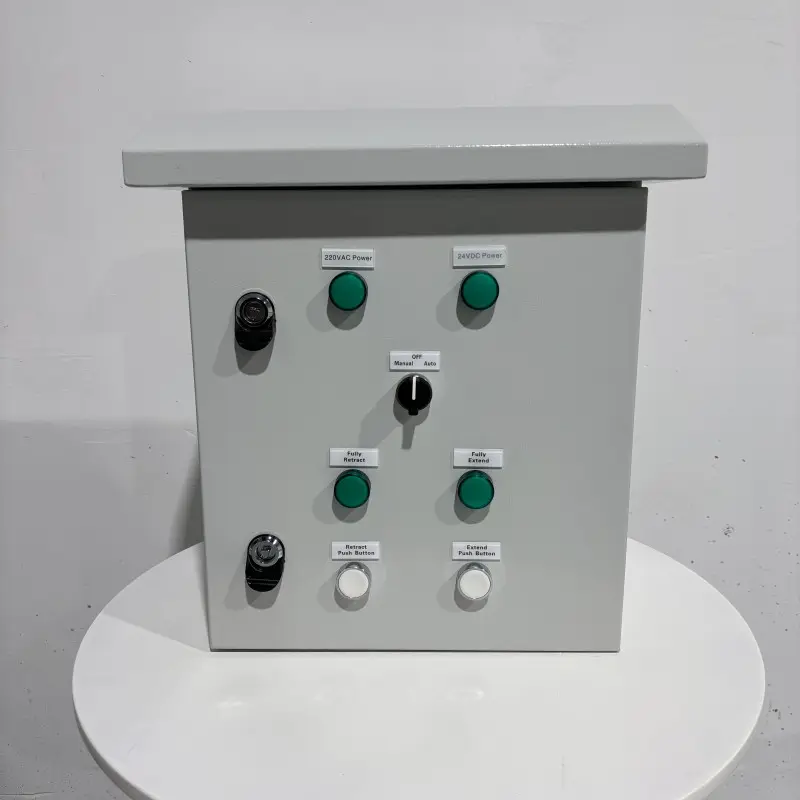Maximizing Airflow: The Role of Fan Control Cabinets in HVAC Systems
In modern HVAC systems, maximizing airflow is essential for maintaining indoor comfort, improving air quality, and ensuring energy efficiency. Airflow impacts everything from temperature regulation to system durability. Fan control cabinets play a pivotal role in controlling industrial and commercial fans, enabling HVAC systems to respond dynamically to varying demands. Understanding their function is key to effective airflow management.
The Importance of Maximizing Airflow in HVAC Systems
Maximizing airflow means delivering the optimal volume of air through ductwork and vents to meet heating, cooling, and ventilation needs. Uncontrolled or excessive airflow can lead to wasted energy, noise issues, and equipment damage. Intelligent control that matches real-time requirements is crucial to maintain efficiency, making maximizing airflow a technical priority in HVAC design and operation.
Components and Operation of Fan Control Cabinets
Fan control cabinets are sophisticated assemblies that combine multiple essential components to effectively manage and regulate the operation of fans within HVAC systems. Among these components are variable frequency drives (VFDs), which play a crucial role by varying the electrical frequency supplied to fan motors, thereby enabling precise control over motor speed. This capability allows fans to operate at different speeds according to demand, rather than running at full speed continuously, which significantly improves energy efficiency.
In addition to VFDs, programmable logic controllers (PLCs) serve as the intelligent control units within the cabinet. PLCs process input signals from various sensors and execute programmed instructions to coordinate fan operation, including start and stop sequences, speed adjustments, and fault detection. Contactors are also integrated into the cabinet, functioning as electrical switches that control the power supply to the fans, ensuring smooth and reliable motor engagement and disengagement.
Overload protection devices are critical safety features incorporated within fan control cabinets to monitor motor current and prevent damage due to electrical overloads or mechanical faults. These devices automatically disconnect power in unsafe conditions, protecting both the equipment and the broader HVAC system.
User interfaces, which may include touchscreens or control panels, provide operators with the ability to monitor system status, adjust settings, and manually override automated controls if necessary. Through the seamless cooperation of all these components, fan control cabinets can dynamically adjust fan speeds in response to real-time sensor feedback, such as temperature, pressure, or airflow measurements. This adaptive control enables HVAC systems to maximize airflow efficiency, delivering the right amount of air where and when it is needed, while simultaneously minimizing energy consumption and reducing operational costs.
How Fan Control Cabinets Enhance Airflow Efficiency
Fan control cabinets enable HVAC systems to operate fans at variable speeds that closely align with the actual airflow requirements of a space or process. Rather than running fans continuously at full speed—which can lead to excessive energy consumption and wear—these cabinets allow fans to adjust their speed dynamically. This targeted operation prevents unnecessary power usage and reduces strain on the equipment, contributing to longer motor life and lower maintenance costs.
By integrating a variety of sensors that continuously monitor environmental parameters such as temperature, pressure, and humidity, fan control cabinets gather real-time data essential for airflow regulation. When conditions indicate a need for increased ventilation, the system responds by ramping up fan speeds; conversely, when demand decreases, the fans slow down accordingly. This adaptive response improves the uniformity and efficiency of air distribution throughout the HVAC system, ensuring comfort and proper ventilation.
Such precise and responsive control mechanisms are fundamental to maximizing airflow, especially in environments where conditions fluctuate frequently. Through this smart modulation, fan control cabinets help HVAC systems maintain optimal performance, energy efficiency, and indoor air quality under varying operational scenarios.

Benefits of Maximizing Airflow through Fan Control Cabinets
Maximizing airflow offers numerous advantages:
- Energy Savings: By matching fan speed to demand, energy consumption is lowered.
- Improved Air Quality: Consistent airflow promotes effective ventilation, reducing stale air.
- Extended Equipment Life: Reduced mechanical stress leads to longer-lasting fans and motors.
- Noise Reduction: Operating fans at variable speeds reduces noise pollution.
- Enhanced System Reliability: Dynamic control prevents overheating and system faults.
These benefits combine to lower operating costs while improving occupant comfort and safety.
Applications of Fan Control Cabinets in Different HVAC Environments
Fan control cabinets find extensive application across a broad range of settings, including commercial buildings, industrial manufacturing plants, data centers, healthcare facilities, and educational institutions. In each of these environments, the ability to precisely regulate airflow is critical to maintaining optimal conditions. For example, commercial buildings require airflow adjustments based on varying occupancy levels throughout the day, while industrial plants often need to control ventilation to manage fluctuating heat loads or remove airborne contaminants. Data centers depend on accurate airflow management to prevent overheating of sensitive equipment, and healthcare facilities rely on strict airflow control to maintain sterile and safe environments. Educational institutions also benefit from adaptable ventilation to ensure comfort and air quality for students and staff.
Because these environments have diverse and dynamic airflow demands, fan control cabinets serve as indispensable tools that enable HVAC systems to respond effectively to changing conditions. Their ability to customize and maximize airflow ensures energy efficiency, occupant comfort, and compliance with safety and environmental standards across a wide spectrum of HVAC applications.
Selecting Fan Control Cabinets for Effective Airflow Management
Selecting the appropriate fan control cabinet is a critical decision that requires careful consideration of several key factors to ensure optimal performance and compatibility. First and foremost, the cabinet must be properly matched to the specific fan size and type used in the HVAC system, as this affects power requirements and control capabilities. Additionally, control flexibility is essential—choosing a cabinet that supports a range of control options, including manual overrides and programmable logic, allows the system to adapt to varying operational demands.
Environmental protection ratings are also important, especially if the cabinet will be installed in harsh or variable conditions; a suitable enclosure must provide adequate resistance to dust, moisture, temperature fluctuations, and other environmental stresses to ensure long-term reliability. Furthermore, compatibility with communication protocols such as Modbus, BACnet, or Ethernet/IP is necessary for seamless integration with existing building management systems, enabling centralized monitoring and control.
Customizability is another important consideration, as it allows the fan control cabinet to be tailored to the specific functional and operational requirements of your HVAC system. Making the right choice not only guarantees smooth integration but also ensures that the system can maximize airflow efficiently and respond dynamically to changing conditions.
Working with a reliable and experienced supplier is equally vital. A trusted partner can provide expert guidance, offer solutions customized to your unique needs, and deliver ongoing technical support—ensuring your fan control cabinet performs optimally throughout its service life and helps you achieve superior airflow management.
Maintaining Fan Control Cabinets for Optimal Performance
Routine maintenance helps maintain airflow efficiency and prolongs cabinet lifespan. Regular checks of wiring, sensors, cleaning, and diagnostics are necessary. Preventive maintenance reduces downtime and supports continuous operation, ensuring that airflow remains maximized over time.
Frequently Asked Questions
What does maximizing airflow achieve in an HVAC system?
It ensures the delivery of optimal air volumes for comfort and efficiency, avoiding wasted energy and maintaining system health.
Can fan control cabinets be installed in existing HVAC setups?
Yes, they are designed for retrofit as well as new installations, enabling improved airflow control without major overhauls.
How do fan control cabinets contribute to energy savings?
By adjusting fan speeds based on demand, they reduce electricity use compared to constant full-speed operation.
Are fan control cabinets user-friendly?
Modern cabinets include intuitive interfaces and programmable controls for ease of operation.
In which environments are fan control cabinets most beneficial?
They are ideal for any setting where precise airflow management impacts comfort, safety, or equipment function.
How often should these cabinets be inspected?
A maintenance schedule of every 6 to 12 months is recommended to ensure consistent performance.
Table of Contents
- Maximizing Airflow: The Role of Fan Control Cabinets in HVAC Systems
- How Fan Control Cabinets Enhance Airflow Efficiency
- Selecting Fan Control Cabinets for Effective Airflow Management
- Maintaining Fan Control Cabinets for Optimal Performance
-
Frequently Asked Questions
- What does maximizing airflow achieve in an HVAC system?
- Can fan control cabinets be installed in existing HVAC setups?
- How do fan control cabinets contribute to energy savings?
- Are fan control cabinets user-friendly?
- In which environments are fan control cabinets most beneficial?
- How often should these cabinets be inspected?


